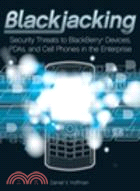| FindBook |
有 1 項符合
BLACKJACKING的圖書 |
 |
BLACKJACKING 作者:HOFFMAN 出版社:JOHN WILEY & SONS 出版日期:2007-01-01 |
| 圖書館借閱 |
| 國家圖書館 | 全國圖書書目資訊網 | 國立公共資訊圖書館 | 電子書服務平台 | MetaCat 跨館整合查詢 |
| 臺北市立圖書館 | 新北市立圖書館 | 基隆市公共圖書館 | 桃園市立圖書館 | 新竹縣公共圖書館 |
| 苗栗縣立圖書館 | 臺中市立圖書館 | 彰化縣公共圖書館 | 南投縣文化局 | 雲林縣公共圖書館 |
| 嘉義縣圖書館 | 臺南市立圖書館 | 高雄市立圖書館 | 屏東縣公共圖書館 | 宜蘭縣公共圖書館 |
| 花蓮縣文化局 | 臺東縣文化處 |
|
|
- 圖書簡介
Today, it is almost impossible to do business without a cell phone and a BlackBerry or PDA. These devices are the lifeline for companies large and small—and nobody knows this better than a hacker. Traditionally, security for mobile devices has held a low priority. Now, a certified ethical hacker explains in this book why this must change and how to change it. Packed with sobering examples of actual attacks, this unique resource shows you how to mount your counterattack.
- 作者簡介
Daniel V. Hoffman, CISSP, CEH, CWNA has more than a decade of experience in remote-access security. He has built his expertise as an IT Director and U.S. Coast Guard Telecommunications Specialist, and is currently a Senior Engineer architecting security solutions for the largest companies in the world. He is known for his live hacking demonstrations, and his hacking videos have been featured in the Department of Homeland Security's open source infrastructure report.
- 目次
About the Author.
Acknowledgments.
Introduction.
Chapter 1 Understanding the Threats.
Quantifying the Threat.
The Malware Threat.
Direct Attack.
Data-Communication Interception.
Authentication Spoofing and Sniffing.
Physical Compromise.
Mobile Device Enterprise Infrastructure.
PC and LAN Connectivity.
Fundamental Changes in Security Strategy.
Protecting the Mobile Device Itself.
Enforcing Compliance on the Mobile Device.
Addressing Security Deficiencies Automatically.
Implementing Layered Security.
Controlling and Protecting Data.
Things to Remember.
Chapter 2 Understanding the Devices.
BlackBerrys.
BlackBerry Business Phones.
BlackBerry Handheld Devices.
BlackBerry-Enabled Devices.
Pocket PCs.
Dell Axim Pocket PCs.
HP Pocket PCs.
Palm Pocket PCs.
Motorola Pocket PC.
Palm Handhelds.
Palm Smartphones.
Cell Phones.
Symbian OS Cell Phones.
Non–Symbian OS Cell Phones.
Things to Remember.
Chapter 3 Exploiting BlackBerry Devices.
Malware Is Threatening Your BlackBerry.
Analyzing a Malware Attack.
Gathering Information.
Setting Up for the Attack and Covering His Tracks.
Launching the Attack.
Protecting Against This Attack.
Learning about New Vulnerabilities.
BlackBerry Antivirus Software.
Attacking a BlackBerry Directly.
Attacking via IP Address.
Attacking via Malware.
Antimalware Applications.
Enterprise-Grade Firewall with IDS/IPS.
The BlackBerry Firewall.
Ensuring the Device Has the Latest Updates.
Educating Users about Risks.
Intercepting BlackBerry Communication.
What Data Is Being Transmitted?
How Is Data Being Transmitted?
Carrier Internet Access.
Bluetooth.
The BlackBerry Wi-Fi Interface.
Physically Compromising a BlackBerry by Spoofing and Intercepting Authentication.
How Physical Compromise Happens.
Preventing Physical Compromise.
Protecting a Stand-Alone BlackBerry.
Preventing Unauthorized Access.
The Truth About Wiping A Lost or Stolen BlackBerry.
Implementing Content Protection.
Spoofing and Intercepting Authentication.
BlackBerry Security Checklist.
Things to Remember.
Chapter 4 Hacking the Supporting BlackBerry Infrastructure.
Good and Bad: A Conduit to Your LAN.
Understanding the BlackBerry Infrastructure.
BlackBerry Infrastructure Components.
Infrastructure Design Considerations.
Attacking the BlackBerry Infrastructure.
The Attacker’s Side of the Story.
Insecure Server Configuration.
Insecure Topology.
BBProxy.
Things to Remember.
Chapter 5 Protecting Your PC and LAN from BlackBerrys.
Controlling Data Is Critical.
How Companies Lose Control of Data.
How to Control Data.
Create and Communicate a Formal Policy.
Enforce Security Policies with Available Technology.
Threats from BlackBerry-Provided Internet Access.
Internet Attack.
The Attacker’s Side of the Story.
Preventing the Attack.
Stay Up-to-Date with Patches.
Use a Personal Firewall.
Controlling Data Coming from a BlackBerry.
Analyze the Data Coming from the BlackBerry.
Analyze the Data as It Resides on the BlackBerry.
Control Which Devices Can Connect to Your Enterprise PCs.
Things to Remember.
Chapter 6 Exploiting PDAs.
Corrupting Your PDA with Malware.
Backdoor Malware for the Pocket PC.
Other PDA Malware.
PDA Antimalware Programs.
Kaspersky Security for PDAs.
JSJ Antivirus.
Trend Micro Mobile Security.
Symantec AntiVirus for Handhelds.
McAfee VirusScan Mobile.
Targeting a PDA Directly.
Finding a PDA.
Making a PDA Stealthy.
PDA Firewall Applications.
Trend Micro Mobile Security (for PDA).
Airscanner Mobile Firewall (for Pocket PC).
Intercepting PDA Communication.
Surfing the Internet at Public Wi-Fi Hotspots.
Using IM and Checking Email at Public Wi-Fi Hotspots.
Using Virtual Private Networks (VPN) to Secure Data.
PDA Authentication Spoofing and Interception.
Sniffing Email Authentication.
Stealing Credentials with Access Point (AP) Phishing.
Intercepting Authentication via SSL Man-in-the-Middle.
Compromising the PDA Physically.
Controlling Access to the PDA.
Palm PDA Security.
Pocket-PC Security.
Encrypting Data on the PDA.
Palm PDA Encryption.
Pocket-PC Encryption.
Things to Remember.
Chapter 7 Hacking the Supporting PDA Infrastructure.
Connecting a PDA to the LAN Is Good and Bad.
You Get What You Pay For.
Strengthen the Wireless Infrastructure.
Using PDA VPN Clients to Protect the Infrastructure.
Be Smart about Providing Access.
Protect Credentials — Protect the Infrastructure.
Control Access to Email with VPN Clients.
Things to Remember.
Chapter 8 Protecting Your PC and LAN from PDAs.
Connecting PDAs to Enterprise Resources.
Transferring Data with a Pocket PC.
Transferring Data with a Palm Device.
Why Transferring Data Is a Problem.
PDAs May Be Contagious.
Good Intentions, Bad Results.
Anatomy of an Infection.
Infection by a Pocket PC.
Infection by a Palm Device.
Preventing PDAs from Bringing Malware into the Enterprise.
Ensure PCs Are Using Antivirus Software Properly.
Ensure All PDAs Contain Antivirus Software.
Control Whether PDAs Can Connect to PCs.
Centralized Management Tools for the PDA.
Things to Remember.
Chapter 9 Exploiting Cell Phones.
Cell-Phone Malware.
The King of All Cell-Phone Malware?
FlexiSpy: Trojan or Valid Software?
Other Cell-Phone Malware.
Stopping Cell-Phone Malware.
Trend Micro Mobile Security for Symbian.
Symantec Mobile Security for Symbian.
F-Secure Mobile Security.
Stealing Data via Bluetooth.
Discovering a Cell Phone via Bluetooth.
Attacking a Cell Phone via Bluetooth.
Preventing Bluetooth Attacks.
Intercepting Cell-Phone Communication.
Physical Compromise and Cell-Phone Authentication Spoofing.
A Real-World Example.
Analyzing Physical Tampering.
Preventing Physical Tampering.
Spoofing Authentication with a Cell Phone.
Things to Remember.
Chapter 10 Protecting the Enterprise PC and LAN from Cell Phones.
Cell Phones May Bring in Malware.
How It Happens.
How to Stop the Attack.
Exposing Enterprise Email.
A Creative Way to Access Enterprise Email.
Prevent Email Forwarding.
Exporting Enterprise Data and Clandestine Data Gathering.
Mobile Phone Tools.
Clandestine Information Gathering.
Things to Remember.
Index.
|











